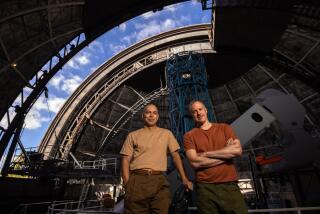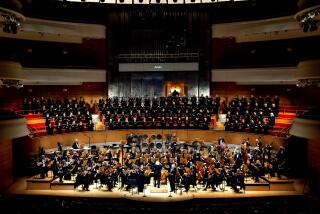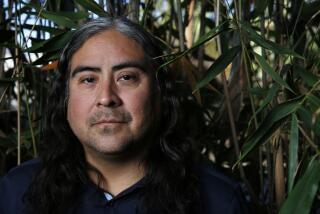All-night journey traverses the soul
- Share via
LONDON — As if for a red-eye flight, we were advised to arrive at Temple Church an hour early Friday night for the premiere of John Tavener’s “The Veil of the Temple.” Takeoff was at 10 p.m.; arrival was set for 5:30 the next morning. Within this numinous jumbo jet, some 150 singers and musicians and an audience of about 300 would take an all-night journey of the soul.
The composer said on BBC radio a couple of hours before the concert that while writing the climactic section, meant to be performed as the new day breaks, he had a vision of paradise. Composing this epic 800-page score, Tavener also claimed, cured him of his sleeping-pill habit and his desire to consume copious amounts of wine.
Sir John offered one warning, though: Don’t come as a critic. You must give yourself over to the experience. Feeling game, I left my pen at the hotel and reached the historic church, built by Crusaders in 1185, with plenty of time for pre-boarding.
Ushered inside in small groups, we were told that the piece unfolds in eight cycles without a break, but we were invited to walk around the glorious church during the performance and to come and go. Outside a food wagon operated throughout the night, and the Temple’s splendid lunchroom remained open. The pews were surprisingly comfortable; at each seat was a cushion and two large chocolate bars -- one milk, the other dark.
Tavener has been a leading British composer since the Beatles released his cantata, “The Whale,” on their Apple label in 1968. With his conversion to the Greek Orthodox Church a few years later, he forswore the avant-garde and Modernism, but he has developed a wide following for his mystically enveloping, slow-moving, exotically ecstatic music, and his “Song for Athene,” performed at Princess Diana’s funeral, made him a celebrity. Prince Charles is the patron for “The Veil of the Temple,” which is also sponsored by the City of London Festival.
The evening began in a veil of mystery with a poem by Jalaluddin Rumi, the 13th century mystical Sufi poet, sung in the outer round temple and out of sight by the soprano Patricia Rosario and accompanied by a duduk. Then in the center of the church was the rousing sound of a huge Tibetan horn, calling us to prayer.
Although Tavener’s music often hints at Eastern religious traditions, particularly of India, it has always been intensely Orthodox Christian in its essence. That is still true, but in the program Tavener writes that he now believes the one way to apprehend the vastness of God is to witness many religious traditions.
Each of the first seven cycles proceeds with a sequence of biblical and Gnostic texts and with the occasional outside insertion, such as the opening Rumi. The audience sat on two facing sides of the Temple, with platforms on the other two sides for the chorus. With areas for the percussion instruments, electric synthesizer and brass, the space was inventively used, with music constantly moving around the listeners. Small at first, the musical forces grew larger throughout the night, as the first seven cycles got progressively longer.
The great beauty of this music and the extraordinary singing of the Choir of the Temple Church and the Holst Singers, tirelessly conducted by Stephen Layton and James Vivian, is what got me first. This is English choral singing at its best. With continual flexibility, singers and soloists assumed a range of styles, ranging from Byzantine to madrigal to Asian drone, all with mesmerizing splendor.
There was tedium, especially in the devout solo chanting of long passages of the Gospel of St. John, the Beatitudes and the Psalms. With each cycle, more text was added, and that began to seem worrisome by the fourth cycle. The repletion also started to seem a bit dull. But there was the compensation of all the added musical embellishment, and the best parts kept getting better. By the seventh cycle, which began around 3, the work reached a point of tremendous, even overwhelming grandeur. Suddenly nothing was boring anymore, and even the long chanting of the Gospel passage by an unidentified tenor had become astounding in its melismatic complexity. If Tavener could top that, I thought, he just might have a vision of paradise in store.
But in the eighth cycle, with the chorus changing its black shirts to white, a children’s chorus and brass players having arrived, it all turned, at least for this attempting-to-be-uncritical critic, to bombast.
Here the veil is lifted, and East and West become one. As the stained-glass windows started to become illuminated, Rosario, who had introduced each cycle, heroically intoned dazzling high Cs. The organ thundered. The choruses surrounding the audience quoted, for some strange reason, the mysterious, eros-drenched night music of Wagner’s “Tristan and Isolde.” There was braying of brass, a final majestic “OM” and the Sanskrit “Tat tvam asi” (Thou art that), which the late mythologist Joseph Campbell often invoked to symbolize universal spiritual implications.
But perhaps too much was too much, and the climax felt anti-climactic. We had landed early, a bit before 5. As the composer led us out in procession, one man turned to me and said, “Charming, isn’t it?” I had hoped for more than charm and within the seventh cycle found quite a bit more. Perhaps the problem was all in the expectations.
The performance was recorded for eventual release, and the work will be given in an abridged two-hour version (cycles seven and eight) Tuesday, then repeated in its entirety July 4.
More to Read
The biggest entertainment stories
Get our big stories about Hollywood, film, television, music, arts, culture and more right in your inbox as soon as they publish.
You may occasionally receive promotional content from the Los Angeles Times.











